| trends in advertising | ||
|
Abstract Traditional
advertising practices face new technological challenges. Speakers
Defining coolness as the style or perspective of "the lone, alienated individual, regarding society scornfully," Frank said that contemporary advertising embraces our suspicions of commercial culture and panders to our willingness to believe the worst, while celebrating coolness as "both the ultimate consumer posture and the ne plus ultra of dissidence." Today, he said, business has largely conquered the world, and presents itself as the organizing principle of global civilization, "with editorial writers and pundits everywhere agreeing that the market now overshadows every other way of organizing human affairs." We spend more time at work than ever before, Frank said. "There are more drug tests, more personality tests." At the same time, this is a corporate culture that that does not demand "order, conformity, gray clothes, and Muzak." In fact, it presents itself as an opponent to those very conceptions of corporate life. "Those who speak for the new order aren't puritanical," Frank said, "they're hip, they're fully tuned in to youth culture, they listen to alternative rock while they work, they fantasize about smashing convention. Business theory today is about revolution, not about stasis or hierarchy; it's about liberation, not order." Whatever else it might be, Frank asserted, "coolness is most definitely not something that's going to be a sustainable basis for collective political action of any kind." This makes for a national culture marked by the coexistence of extreme political apathy on the one hand, and what he called "extreme commercial extremism" on the other. He went on to explain that the word "extreme" has supplanted the word "liberal" as what he called "the political slur du jour; the sure-fire way to derail an opponent's campaign." In contrast, he pointed out, in advertising the word "extreme" is virtually everywhere, from Taco Bell's various extreme combos to Pontiac commercials in which the company announces that it is "taking it to the extreme," to an extreme candy bar in France. Furthermore, Frank said that much of today's advertising speaks directly to the problems of media concentration and corporate power. "It makes exemplary use of all those classic images of the mass society," he said. "People in the workplace as robots, in uniform gray, trapped in box-like elevators and cubicles, driven by sadistic bosses." Advertising recognizes that consumer society hasn't given us the things it promised or solved the problems it was supposed to: that consumerism has resulted in the "rat race. The treadmill. The office as hell." Frank called this particular form of advertising "liberation marketing. It knows that business has conquered the world. And it offers in response not just soap that gets your whites whiter, but soap that liberates you, soda pops that are emblems of individualism, radios of resistance, carnivalesque cars, and counter-hegemonic hamburgers. Liberation marketing takes the old mass culture critique -- consumerism as conformity -- fully into account, acknowledges it, addresses it, and solves it. Liberation marketing imagines consumers breaking free from the old enforcers of order, tearing loose from the shackles with which capitalism has bound us, escaping the routine of bureaucracy and hierarchy, getting in touch with our true selves, and finally, finding authenticity, that holiest of consumer grails." One of the most important instances of liberation marketing, Frank said, was the Macintosh TV commercial from 1984 in which "armies of people in gray were freed from the iron grip of Big Brother's propaganda telescreens. We are a nation of look-alike suckers," Frank said of the ad, "We are glued to the tube, fastening intently on the words of The Man. That is, until Macintosh arrives." Liberation marketing, Frank said, "works not only to redefine dissent, but to occupy the niche that dissident voices used to occupy in the American cultural spectrum" resulting in a high degree of political apathy. With its constant talk of liberation, he continued, "the advertising industry is filling a very specific niche in the cultural spectrum of the businessman's republic. As business replaces civil society, advertising is taking over the cultural functions that used to be filled by the left. As American politics become ever more deaf to the idea that the market might not be the best solution for every social problem, the market, bless its invisible heart, is seeing to it that the duties of the left do not go unfulfilled. "Advertising will go on telling us that the problem with society is conformity, and that the answer is carnival, as long as there remains a discretionary dollar in the last teenager's allowance."
To illustrate
the monologue mindset, Montague showed a short clip from the
1947 film The Hucksters in which the owner of a soap
company played by Sydney Greenstreet explains that there is
no difference between his company's soap and other soaps on
the market except for perfume and color. This monologue approach assumes that consumers are passive, Montague explained. "But with new technology, power has shifted away from the producers of products to the consumers." The participative communication model is the opposite of the monologue approach in every way, Montague said. "Participative advertising is not arrogant, but humble and inclusive. It doesn't barge in, but asked to be invited. It trusts the consumer and puts their needs before its own…. Participative advertising is designed for a world in which consumers are in charge." Montague then showed two television commercials from "the sneaker wars of the early 1990s." The Reebok commercial discussed materials and design and the technology that goes into their sneakers, while the Nike commercial featured Bugs Bunny and basketball star Michael Jordan in a story about saving the world. The commercial ends playfully with Jordan saying, "That's All Folks!" and Porky Pig saying, "Hey, that's my line." The Reebok ad exemplified the monologue approach, Montague explained, while the Nike ad is an early example of the participative model in advertising. "Basically," Montague said, "Reebok brought a knife to a gun fight because they thought they were in a technology war with Nike. Nike understood they were in a war for the hearts and minds of the American consumers, and they gave consumers a compelling and entertaining story that had possibilities beyond the 60-second timeframe of television commercials." Participative advertising is so entertaining or compelling that people want it in their lives, Montague said, and given a choice they will actually request it and, in some cases, they might even pay for it. To illustrate this last point, he played a short clip from the movie Space Jam starring Michael Jordan and Bugs Bunny saying "This is the Hair Jordan concept turned into a two-hour Nike commercial, and people paid $8 to see it. This could never happen in the monologue world, but participative communication makes it possible." As another example of what he considers successful participative advertising, Montague showed a clip from Budweiser's highly popular Wassup? campaign in which men are shown watching television and drinking Budweiser beer and calling one another on the phone to ask, "wassup?" in slangy, drawn-out voices. "At last count," Montague said, "there were about 600 different versions of the Wassup? ad floating around the Web, about 99 per cent of them homemade. The firm that made this ad got people so involved in the campaign that people are making ads for them! That is participative advertising at its finest." Montague predicted that storytelling that takes place simultaneously in different media such as the Web and TV "will become quite common in the future" but qualified that by saying, "technology is only so good at encouraging people to interact with brands, so live events will also be a huge part of what agencies do moving forward." And as we move forward, Montague said, "A lot of really bad ideas are going to see the light of day, but that's not very different from the last 50 years. Whether the advertising message comes from the cathode ray tube in my living room or the liquid crystal active matrix display on my laptop is ultimately irrelevant. The important questions are, "Is an ad uplifting or alienating? Does it make you feel moved or manipulated?" Technology changes but people don't change, Montague concluded. "People will always respond to great stories and great storytelling." Discussion QUESTION: How do your comments apply to business-to-business advertising?
MONTAGUE: I think that companies are nothing more than collections of people, so the things I said about retail advertising applies to business-to-business advertising as well. HENRY JENKINS, CMS: Ty, are you saying corporate advertisers are adopting this playful, transmedia, participatory style of advertising, or do they take themselves too seriously for that to play itself out in that space? MONTAGUE: It depends on the company. The monologue approach is still firmly entrenched, but new technology will speed along the adoption of the participatory approach. Once these companies find it difficult to reach an audience through the medium of 30-second ads, they'll begin to get a lot more creative. MARGARET WIEGEL, CMS: You brought up the role of the viewer in participatory advertising. Tom situates it in the 1960s and Ty mentions a later point. Did it really start in the 1960s, or is there a back history to this carnival play in advertising? Also, is this the death of the 30-second ad? FRANK: The 30-second ad is an art form. They are so much better than the shows they surround. The 30-second ad will change, obviously, but it's not going away. As for the carnival versus the monologue, this goes way back. The film clip that Ty showed in the beginning is from the novel called The Hucksters about a guy who is disgusted by the hard sell monologue style of advertising. In the 1940s and 1950s that style was absolutely in ascendancy. The exemplar of this style was the Ted Bates Agency of the 1950s. Every ad was repetitive; they'd run ads for years without changing them. They repeated ads, and they loved authority. They always had a guy in a lab coat telling you why this potato chip is better than that one. That was all thrown out in the 1960s when the creative style came in to the fore. This is a perpetual cycle. DAVID THORBURN: Can one of you say something about Burma Shave? FRANK:
In the 1920s, a shaving cream called Burma Shave put ads with
fragments of poems on the sides of roads and people would drive
along reading them. They disappeared when the freeways came
along because you drove by too fast to read them. THORBURN: They strike me as participatory advertising of a kind. They are creative to a degree. They depend on poetry. They depend on people riding along watching for them. MONTAGUE: There are definitely examples of participatory ads that predate the 1990s. My primary point is that driven by today's technologies - such as TiVo that can almost instantly eliminate ads from television - there is now direct pressure on marketers to make a message as palatable and as interesting as possible, and that pressure will only grow. Enlightened marketers have been using the techniques for years, but there a lot of people who don't get it and still think the best way to get people to buy their product is to pound them over the head with a giant media hammer. JENKINS: The historical examples that come to my mind are the ads that W.C. Fields did on the Charlie McCarthy Show on radio. The sponsor was Lucky Strike, and Fields would talk about his son Chester, which was a reference to the sponsor's main competitor, Chesterfield cigarettes. In hindsight, those seem like the kind of playful, anti-commercials we're discussing here. QUESTION: You have mentioned how the technology will change advertising. If we look at all the new media technology on the horizon, those are all global media. What impact will globalization have on advertising? FRANK: At the corporate level it is very noticeable. Saatchi and Saatchi was buying everyone out and then they got bought. There is an incredible concentration, but at the same time there is an intense fragmentation of the audience. My own line on globalization is that it doesn't exist. Globalization is an empty signifier. It's an ideological weapon to smite critics. There's been globalization forever. The slave trade was a form of globalization. The world has been getting smaller for centuries. Only in the 1990s did you have people using the term to mean that every world citizen has to adopt the policies of the Republican Party, U.S.A. QUESTION: Ty said technology changes, but people don't. They still want a good story. The public perception of advertising does change. It seems like we are saying that people do change, that now they are resistant to the monologue approach of advertising. Do you see a time when people grow tired of this participatory approach; grow tired of being manipulated into participating? What do you see happening then? MONTAGUE: The honest answer is I don't have the foggiest idea. The Internet changes everything including the conception of the corporation as walled city. If that is the case, people will be further armed with information. The Internet is why so many people know about Nike's labor problems in Southeast Asia. In the 1950s, Nike would have had an easier time controlling that information. That information is out and they must contend with it as a corporation. I don't know where that process ultimately ends up, but people are smart and know when they are being manipulated and the whole purpose of advertising is to manipulate people. But there is good manipulation and bad. You can do it in a way that makes people feel manipulated and used and dishonored or in a way that makes people feel they are in on it and having a good time with it. Ultimately, that is the difference between good advertising and bad advertising. QUESTION: Soon we may be getting almost everything from the mobile phone. How will advertising be different on mobile phones, or will it be the same as on TV once we have the bandwidth? MONTAGUE: That's a medium that will be badly abused and very annoying. The idea of an ad appearing on my phone seems not only non-participatory, but a lousy thing to do to someone. I have heard of a technology that allows a company to know you are walking past their doorway, so you'll get a ring on the phone saying come on in we're having a sale. I would also find that intensely annoying. Most of that is self-regulating and a lot of people are going to try a lot of bad ideas. Ultimately, most of us are way too old to decide what happens because it is 13 year olds who will determine what is acceptable and what is not acceptable in those new media. QUESTION: Ty, you emphasized that we are seeing a shift in power, what kind of power are you talking about in that context? MONTAGUE: In the three-network world, I could run a roadblock and make sure that everyone with a TV on would see a particular message. That is no longer possible - people can watch what they want when they want. In that environment, the idea of a message that's pushed onto people doesn't work; annoying people into buying a product is no longer a valid premise. Innovation will be driven by direct pressure on the part of the public on marketers. In advertising, we have to figure out what people really want and get better at serving it up in a way either more or as entertaining as the programming it surrounds, or in a way it is most useful. FRANK: This is close to the central idea of my book One Market Under God. In the day when we had three networks and we couldn't talk back, we also had a powerful labor movement in this country; we had a powerful Democratic party; and a more equitable distribution of wealth. Now, organized labor is less than 10 percent of the workforce, and the Democratic Party is adopting the language of the market. At the same time, in the corporate world there is this massive concentration of power. My book was published by Doubleday, which is owned by Bertelsmann, which controls about 30 percent of the American book publishing market. The trend in every industry is toward concentration because antitrust law is no longer enforced. Back in the early 1960s, when Random House got together with Knopf, the antitrust people were on the phone the next morning looking into it. Now, you have a company controlling 30 percent of the market, and the two biggest companies in the industry are both from Germany, and no one lifts a finger. You can make your own Web page, but try forming a union. You can't do that in America anymore. QUESTION: I am an ex-Ogilvy guy, and ad man David Ogilvy used to say that advertising has to make the cash register ring. So, where's the evidence that participative advertising makes the register ring? In the heyday of Budweiser's Wassup? advertising campaign, I was watching sales data and Bud's sales were dead flat. FRANK: This goes back to the 1960s when the last big creative revolution was going on. By the end of the decade, you had these crazy campaigns that were entertaining to the audience, but had little to do with selling a product. In the 1970s you had this reaction against creative advertising. You had the lines drawn in the world, people who said creativity works and those that said it didn't. The Wall Street Journal has been a perpetual enemy of creative advertising.
QUESTION:
How does this movement toward participatory advertising change
the shape of the industry? How are the agencies themselves affected
by these changes? FRANK: It's amazing because that is exactly what happened in the 1960s. It is uncanny. I recently interviewed a guy. It's an advertising think tank. They are a brand agency. Big ad agencies hire him and his friends to sit around and think about the nature of your brand. They don't make the ad. They just figure out your brand for you. MONTAGUE: With the confluence of advertising and entertainment, there are people from the entertainment industry deciding whether to get into the advertising business, and at the same time large holding companies are talking about buying talent agencies in Hollywood to get their hands on the star power. So, there are all kinds of jostling going on in the business right now. I have always heard that penguins jostle one another on an iceberg until one falls in the water and the rest stand there and see if there is a tiger shark under the ice. That's what's happening in advertising. We're on the edge of some important change, but no one knows what it will be. PETER WALSH: Because of the way market research feeds into advertising, I have always thought of advertising as a sort of a public version of the Freudian idea of a dream or secret desire. What's the secret desire being picked up on here? MONTAGUE: That's right. I think we do pick up on these suppressed cultural desires and it is reflected in the work we do. There are certain truths that you can touch on and play with and certain are taboo and much of that is contextual and changes over time. It is a sort of collective cultural hallucination or dream. QUESTION: What is the effectiveness of subliminal advertising? FRANK: Oh, man. Ty, you said it works. MONTAGUE: I was kidding. Sixty percent of Americans believe in subliminal advertising because we are willing to believe that advertising does such devious and nefarious things. But it doesn't exist. QUESTION: When Weiden + Kennedy talks to a prospective client, you don't say the audience is going to create ads for them. I am sure you tell them you'll create the illusion that the audience has control. MONTAGUE: I tell clients the same thing I have told you, but I have three minutes to say it instead of 30. I tell them, 'You are no longer driving the bus.' FRANK: This is something you find in a lot of advertising books such as Under the Radar. The idea that there is a huge cataclysm coming and the advertiser has to change their style. This is usually cited when one company is trying to get an account. QUESTION:
What about advertising in America after the terror attacks of
September 11? What about this patriotic branding, such as with
truck and car advertising that implores us 'to 'keep America
moving'?
MONTAGUE: I find it really objectionable. My recommendation to clients who asked me about it was, 'Say nothing, this is not about you and you should stay out of it.' The car industry in particular has been very bad in the way it has attempted to attach itself to the desire on the part of people to pull together. It's manipulative in a bad way. But, I also think people see through that and the advertisers are ultimately hurting themselves by doing stuff like that. JENKINS: There was a remarkable ad in a recent issue of New Yorker. It was a fashion ad that appears to show a woman in a fur and boots in what could be a cave in Afghanistan. I am sure it was shot before Sept. 11, but it struck me as particularly odd to have this woman in the cave, smoke coming out of a cave, a guy in the background wearing a turban in an ad as if this image didn't have a lot of resonance in recent weeks. MONTAGUE: The fashion industry is a nation onto itself. I don't get it. It freaks me out.
MONTAGUE: Those are some of my favorite ads; those that get the reaction, "What?" QUESTION: Is there a known dosing effect? Is there any evidence that advertising is cumulative in its impact? FRANK: They used to think so in the 1950s, but there are different schools of thought. MONTAGUE: Right, there is the school that you saw in The Hucksters clip that says you can annoy people into buying your product. I think that's non-participative and will turn people off. You want to engage and delight them. It only works if you delight them with something new otherwise the delight becomes annoyance. THORBURN:
Implicit in the last question but all the way through this discourse
has been the notion that over time the audience becomes more
and more literate and, in the case of advertising, more and
more skeptical. Isn't the increasing skepticism on the part
of the audience indicative of hostility toward advertising?
In fact, don't we have an adversarial relationship in which
the audience tries to elude these ads and advertisers find ways
to overcome our efforts?
|
||

 THOMAS
FRANK explained how advertising has co-opted an anti-corporate,
even anti-advertising sensibility, a strategy he calls "liberation
marketing," which he explores more fully in his book The
Conquest of Cool.
THOMAS
FRANK explained how advertising has co-opted an anti-corporate,
even anti-advertising sensibility, a strategy he calls "liberation
marketing," which he explores more fully in his book The
Conquest of Cool.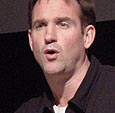 TY
MONTAGUE said there are currently two competing models of
communication being applied by advertisers: the monologue approach,
a one-way communication model that he said has dominated advertising
for the last 50 years and is now in decline; and a two-way model
of communication, seeking to establish a dialogue with consumers,
which Montague called "participative" advertising.
TY
MONTAGUE said there are currently two competing models of
communication being applied by advertisers: the monologue approach,
a one-way communication model that he said has dominated advertising
for the last 50 years and is now in decline; and a two-way model
of communication, seeking to establish a dialogue with consumers,
which Montague called "participative" advertising.
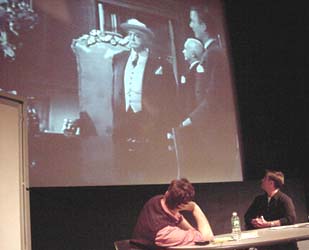 "Why
do we outsell them?" the owner asks. "Because we out-advertise
them," he says and goes on to define successful advertising
as a form of irritation through repetitive imagery and jingles.
"Repeat it [the jingle] until it comes out of their ears,"
he says.
"Why
do we outsell them?" the owner asks. "Because we out-advertise
them," he says and goes on to define successful advertising
as a form of irritation through repetitive imagery and jingles.
"Repeat it [the jingle] until it comes out of their ears,"
he says.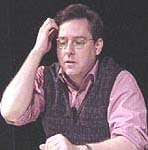 FRANK:
This is a part of advertising I haven't seen anyone write
about. As the technology bubble grew ever larger through the
1990s, I started noticing that companies with a certain ad style
that they would show on CNBC or MSNBC would become hot companies.
Maybe they were already hot companies and their ads grew out
of that. But I can't help but believe that some of these companies
were running ads to make themselves attractive to investors.
I think that would be a new thing, I don't know.
FRANK:
This is a part of advertising I haven't seen anyone write
about. As the technology bubble grew ever larger through the
1990s, I started noticing that companies with a certain ad style
that they would show on CNBC or MSNBC would become hot companies.
Maybe they were already hot companies and their ads grew out
of that. But I can't help but believe that some of these companies
were running ads to make themselves attractive to investors.
I think that would be a new thing, I don't know.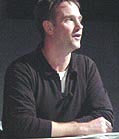 MONTAGUE:
Sometimes it works and sometimes it doesn't and no one can
say why, that is why advertising in not a science, it is an
art. There was a time in the early 1990s that Reebok pulled
ahead of Nike in total world sales and Reebok believed that
the way to sell shoes was to talk about the technology contained
in the sole of the shoe, and the rational benefits of the shoe.
MONTAGUE:
Sometimes it works and sometimes it doesn't and no one can
say why, that is why advertising in not a science, it is an
art. There was a time in the early 1990s that Reebok pulled
ahead of Nike in total world sales and Reebok believed that
the way to sell shoes was to talk about the technology contained
in the sole of the shoe, and the rational benefits of the shoe.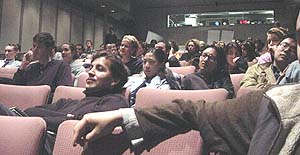
 FRANK:
I got a phone call from a New York Times reporter who
wanted me to explain an ad in Vogue. The ad showed a
stylish woman with her arms at her side and an evil kid on a
slide behind her and I got it and I said, "Oh my God, what
in the hell is this, something from The Omen?"
FRANK:
I got a phone call from a New York Times reporter who
wanted me to explain an ad in Vogue. The ad showed a
stylish woman with her arms at her side and an evil kid on a
slide behind her and I got it and I said, "Oh my God, what
in the hell is this, something from The Omen?"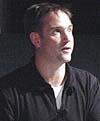 MONTAGUE:
People in advertising like to cast themselves in an important
light: the great struggle to save the world from dandruff. In
that sense, we live in - we have created - a world of hyperbole.
So we are always trying to convince clients of the urgency of
the need to stay on top of the culture; to do anything we can
to penetrate the defenses of a hostile audience, and that hostility
results from old-style communications, from the use of that
monologue model. It is a model that does not accept that people
have choices. In participative communication the goal is the
same - to penetrate defenses - but the weapon is different.
It is humor and interest and engagement and not being annoying
whenever possible.
MONTAGUE:
People in advertising like to cast themselves in an important
light: the great struggle to save the world from dandruff. In
that sense, we live in - we have created - a world of hyperbole.
So we are always trying to convince clients of the urgency of
the need to stay on top of the culture; to do anything we can
to penetrate the defenses of a hostile audience, and that hostility
results from old-style communications, from the use of that
monologue model. It is a model that does not accept that people
have choices. In participative communication the goal is the
same - to penetrate defenses - but the weapon is different.
It is humor and interest and engagement and not being annoying
whenever possible.